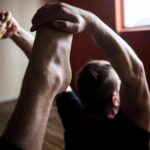The Latest Neuroscience of Breath and Posture
Where the breath goes, awareness flows: How yoga and science guide my path to better posture and peace of mind. Dr Joanna Mills offers her insights grounded in contemporary research on the neuroscience of breath, posture, and their influence on emotional and mental wellbeing.
My posture is deeply affected by my state of mind. When I feel tense, my body stiffens, and my breath becomes shallow. Often, I don’t even realise this until I find myself feeling stuck and uneasy.
Over the last couple of decades, I have spent countless hours hunched over computer screens or buried in books and research papers – first as a student, then as a doctor and researcher. Recently, this habitual pattern has led me to reflect on whether my choices truly align with my values, and whether my physical stance might be offering subtle cues about my emotions. This awareness led me to think about how practicing yoga postures helps me regain balance, focus, and a sense of ease. Naturally, I turned to science to make sense of these connections. What I discovered was fascinating: the interplay between the body, brain, and mind is influenced by breath and movement.

Research shows that controlled breathing engages key muscles, including the diaphragm (our primary breathing muscle), ribs, hips, and lower back, that work together to stabilise the spine and improve posture, and cultivate an awareness of balance (Noble & Hochman, 2019; Tassani et al., 2024; Zaccaro et al., 2018). Furthermore, deep, intentional breaths help calm the body by regulating heart rate and modulating brain signals involved in processing emotions (Folschweiller & Sauer, 2023; Boyadzhieva & Kayhan, 2021; Maric et al., 2020).
Interestingly, this relationship is bidirectional: posture influences emotional states and is, in turn, shaped by them (Hall et al., 2023). For example, sitting upright rather than slouching has been shown to boost mood and self-esteem (Nair et al., 2015). Similarly, walking with an upright posture may reduce emotional stress (Hackford et al., 2019). One particularly compelling study found that expansive, open “high-power” poses were associated with feelings of positivity, while constricted “low-power” poses corresponded with negative emotions (Takayama & Sekiya, 2023). This phenomenon, known as “embodied cognition,” highlights how posture not only mirrors emotional states but also actively influences them.
I am reminded of a phrase I encountered during my yoga teaching training: Where the breath goes, awareness flows. In yoga, balancing poses gently edge us to moments of instability by encouraging us to tune into the breath and consciously turn inward, all while maintaining focus on a single external visual point (or Drishti). This practice teaches us to find comfort in asymmetry – sometimes by holding steady, and other times by relinquishing control and surrendering to imbalance.
My own yoga practice continually reminds me that even when I am uneasy, I can return to my centre by trusting my instincts to breathe and move. These dynamic processes have helped me navigate the ongoing mental tug-of-war between who I am and who I aspire to become. By understanding the profound connection between breath, posture, and mind, I have learned that I can make intentional choices aligned with my values – choices that can bring me balance, clarity, and joy, one breath at a time.
About the Author
Dr Joanna Mills, is a medical doctor, PhD researcher, Defence spouse, and Registered Level 1 Teacher dedicated to improving wellbeing through scientific research and yoga.
References:
- Boyadzhieva, A., & Kayhan, E. (2021). Keeping the breath in mind: Respiration, neural oscillations, and the free energy principle. Frontiers in Neuroscience, 15, 647579. https://doi.org/10.3389/fnins.2021.647579
- Folschweiller, S., & Sauer, J. F. (2023). Behavioral state-dependent modulation of prefrontal cortex activity by respiration. The Journal of Neuroscience, 43(26), 4795 4807. https://doi.org/10.1523/JNEUROSCI.2075-22.2023
- Hall, K. J., Van Ooteghem, K., & McIlroy, W. E. (2023). Emotional state as a modulator of autonomic and somatic nervous system activity in postural control: A review. Frontiers in Neurology, 14, 1188799. https://doi.org/10.3389/fneur.2023.1188799
- Hackford, J., Mackey, A., & Broadbent, E. (2019). The effects of walking posture on affective and physiological states during stress. Journal of Behavior Therapy and Experimental Psychiatry, 62, 80–87. https://doi.org/10.1016/j.jbtep.2018.09.004
- Maric, V., Ramanathan, D., & Mishra, J. (2020). Respiratory regulation & interactions with neuro-cognitive circuitry. Neuroscience and Biobehavioral Reviews, 112, 95–106. https://doi.org/10.1016/j.neubiorev.2020.02.001
- Nair, S., Sagar, M., Sollers, J., 3rd, Consedine, N., & Broadbent, E. (2015). Do slumped and upright postures affect stress responses? A randomized trial. Health Psychology, 34(6), 632–641. https://doi.org/10.1037/hea0000146
- Noble, D. J., & Hochman, S. (2019). Hypothesis: Pulmonary afferent activity patterns during slow, deep breathing contribute to the neural induction of physiological relaxation. Frontiers in Physiology, 10, 1176. https://doi.org/10.3389/fphys.2019.01176
- Takayama, A., & Sekiya, H. (2023). Effects of various sitting and standing postures on arousal and valence. PLoS ONE, 18(6), e0286720. https://doi.org/10.1371/journal.pone.0286720
- Tassani, S., Chaves, P., Beardsley, M., Vujovic, M., Ramírez, J., Mendoza, J., Portero-Tresserra, M., González-Ballester, M. A., & Hernández-Leo, D. (2024). Breathing, postural stability, and psychological health: A study to explore triangular links. Frontiers in Bioengineering and Biotechnology, 12, 1347939. https://doi.org/10.3389/fbioe.2024.1347939
- Zaccaro, A., Piarulli, A., Laurino, M., Garbella, E., Menicucci, D., Neri, B., & Gemignani, A. (2018). How breath-control can change your life: A systematic review on psycho-physiological correlates of slow breathing. Frontiers in Human Neuroscience, 12, 353. https://doi.org/10.3389/fnhum.2018.00353



